
CBSE Guess > Papers > Important Questions > Class XII > 2011 > Physics > Physics By Mr.Ashis kumar satapathy
CBSE CLASS XII
  
Current, Resistance & Resistivity
A: Following questions are very short answer type. They are to be answered in one or two sentences. They may carry one mark each.
- What are the factors on which resistance of a conductor depends? Give the corresponding relation.
- What are Super Conductors?
- Define electrical resistivity of a material. Does it depend on temperature?
- Two wires of equal length, one of copper and the other of manganin, have the same resistance. Which wire is thicker?
- State Ohm's Law.
- How does conductivity of a semi conductor vary with temperature?
- On a given resistor the colour bands are in the sequence Green, Violet and Red. What is its resistance?
- A carbon resistor of 47K ohms is to be marked with rings of different colours for its identification, Write the sequence of colours.
- Manganin is used for making standard resistors. Why?
- A wire of resistivity ρ is stretched to double its length. What will be its resistivity?
- Of metals and alloys, which has greater value of temperature co efficient of resistivity?
- A copper wire of resistivity ρ is stretched to reduce its diameter to half of its previous value. What will be its new resistivity?
- Why is a voltmeter always connected in parallel with a circuit element across which voltage is to be measured?
- Two wires are of same metal, have the same cross sectional area and their lengths are in the ratio 2:1. What will be the ratio of currents flowing through them respectively when the same potential difference is applied across length of each of them?
- A carbon resistor is marked in green, red, and orange bands. What is the approximate resistance of the resistor?
- The pd across a given copper wire is increased. What happens to the drift velocity of the charge carriers?
- If the temperature of a good conductor increases, how does the relaxation time of electrons in the conductor change?
- State the condition in which the terminal voltage across a secondary cell is equal to its emf?
- If pd V applied across a conductor is incrased to 2 V, how will the drift velocity of the free electrons change?
- A carbon resistor is marked in coloured bands of red, black, orange and silver. What is the resistance and tolerance value of the resistor?
- The given graph shows the variation of resistance of mercury in the temperature range 0 < T < 4 K. Name the phenomenon shown by the graph.
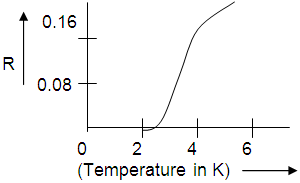
- What will be the change in the resistance of a Eureka wire, when its radius is halved and
length is reduced to one-fourth of the original length?
B: The following questions are of short answer type. Each of them may carry 2 or 3 marks.
- Explain the difference in the temperature variation of resistivity of metals and semi conductors?
- . The sequence of bands marked on a carbon resistor is Brown, Black, Brown and Gold. What is the resistance? Also give the tolerance.
- State Ohm's Law. A carbon resistor has the coloured ring in the sequence Yellow, Violet, Brown and Gold. What is its resistance? Also give the tolerance.
- Assuming that electrons are free inside a solid, sketch graphically the distribution n(v) of electron with velocity v.
- The sequence of marked rings on a carbon resistor is Red, Red, Red and Silver. What is the resistance? Also give the tolerance.
- When a battery of emf E and internal resistance r is connected to a resistance R, a current I flows through it. Derive the relation between E, I, r and R.
- Define Conductivity of material. Give its SI unit.
- State the conditions under which Ohm's Law is not obeyed in a conductor?
- Three resistances P, Q and R are connected in parallel. Derive their equivalent resistance.
- Define Conductance of a material. Give its SI unit.
- A given copper wire is stretched to reduce its diameter to half of its previous value. What will be its new resistance?
- What do you understand by the resistivity of a substance? Discuss its temperature dependence for a
(i) conductor,
(ii) semi conductor and
(iii) electrolyte.
- . What are Ohmic and Non ohmic circuits? Give one example of each.
- Show that one Ampere is equivalent to a flow of 6.25 x 1018 elementary charges per second.
- Define resistivity of a conductor. How does it vary with temperature? Give an experimental method for determining the resistivity of metallic wire.
- The sequence of bands marked on a carbon resistor is Yellow, Red, Orange and Silver. What is its
(i) resistance and
(ii) tolerance?
- A 10 ohms thick wire is stretched so that it length becomes three times. Assuming that there is no change in its density on stretching, calculate the resistance of the new wire.
- A metallic wire of length 1m is stretched to double its length. Calculate the ratio of initial and final resistance assuming that there is no change in its density on stretching.
- A voltage of 30 V is applied across a colour coded carbon resistor with first, second & third rings of Blue, Black and Yellow colours. What is the current flowing through the resistance?
- Define EMF of a cell. Show that the voltage drop across a resistor connected in parallel with a cell is different from the EMF of the cell.
- Calculate the electrical conductivity of the material of a conductor of length 3m, area of cross section 0.02 mm2 having a resistance of 2 ohms.
- A potential difference V is applied across a conductor of length L and diameter D. How are the electric field E and the resistance R of the conductor affected when in turn
(I) V is halved,
(ii) L is halved and
(iii) D is doubled? Justify your answer in each case.
- Why does the resistivity of a semiconductor decrease with increase in temperature?
- The resistivity of a conductor increases or decreases with increase in temperature? Explain.
- Name any two materials having a small value of temperature co-efficient of resistance. Write one use of this material.
- A wire has a resistance of 32 ohms. It is melted and drawn into a wire of half of its original length. Calculate the resistance of the new wire. What is the percentage change in resistance?
- Define resistivity of a substance. Give its unit. How does it vary with temperature in
(I) good conductors,
(ii) ionic conductors, and
(iii) semi conductors?
- V I graph for a metallic wire at two different temp. T1 and
T2 is as shown in the fig. Whichof the two temp. is higher and why
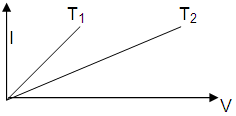
- A wire of 10 Ohms resistance is stretched to thrice of its original length. What will be its
(i) resistivity and
(ii) new resistance?
- A cell if emf, E and internal resistance r gives a current of 0.8 A with an external resistance 24 ohms and a current of 0.5 A with an external resistance of 40 ohms. Calculate
(i) emf E and
(ii) internal resistance r of the cell.
- A conductor of length l is connected to a dc source of potential V. If the length of the conductor is tripled, by stretching it, keeping V constant, explain how do the following factors vary in the conductor:
(i) Drift speed of electrons,
(ii) Resistance and
(iii) Resistivity?
- Define resistivity and state its S.I. unit. State and explain how the resistivity of a conductor varies with temperature?
- Define the term resistivity of a conductor. Give its S.I. unit. Show that the resistance R of conductor is given by ml/(ne2ԏ A), where the symbols have their usual meanings.
- Are the paths of electrons straight lines between successive collisions (with the positive ions of the metal) in the
(i) absence of electric field and
(ii) presence of electric field?
- Establish a relation between drift velocity vd of an electron in a conductor of cross-section A, carrying current I and concentration n of free electrons per unit volume of the conductor. Hence obtain the relation between current density and drift velocity.
- Define resistivity. Write an expression for the resistivity of a conductor in terms of relaxation time.
- Explain how does the resistivity of a conductor change with
(I) number density ‘n’ of free electrons and
(ii) the relaxation time λ ?
- Explain, with the help of graph, the variation of conductivity with temperature for a metallic conductor.
- What is superconductivity? State two applications of the phenomenon of superconductivity.
- Give the nature of V-I graph for
(i) ohmic and
(ii) non-ohmic circuit elements. Give one example of each type.
- The voltage-current variation of two metallic wires X and Y at constant temperature are as shown.Assuming that the wires have the same length and the same diameter, explain which of the two wires will have larger resistance.
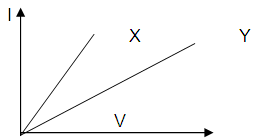
- The voltage-current graphs for two resisters of the same material and same radii with lengths L1 and L2 are shown in the figure. If L1 > L2, state with reason, which of these graphs represents voltage-current change for L1 .
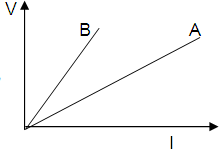
- Breifly explain, how the drift velocity of electrons in a metallic conductor varies, when
(I) the temperature of the conductor is increases, and
(ii) applied potential difference is decreases,keeping temperature constant.
- The diagram shows a piece of pure semiconductor, S in series with a variable resistor R, and a source of constant voltage V. Would you increase or decrease the value of R to keep the reading of ammeter (A) constant, when the semiconductor S is heated? Give reason.
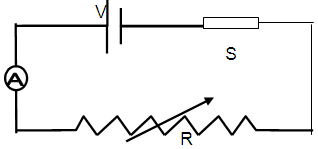
- Draw the graphs to show the variation of resistivity with temperature for
(I) nichrome and
(ii)silicon.
- The circuit shown in the diagram contains a battery B, a rheostat Rh and identical lamps P and Q. What will happen to brightness of the lamps, if the resistance through the rheostat is increased? Give reasons.
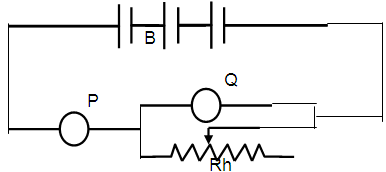
- A voltage of 30V is applied across a carbon resistor with first, second and third rings of blue black and yellow colours respectively. Calculate the value of current in mA, through the resistor.
  
Submitted By Mr.Ashis kumar satapathy
Email Id :[email protected] |
|